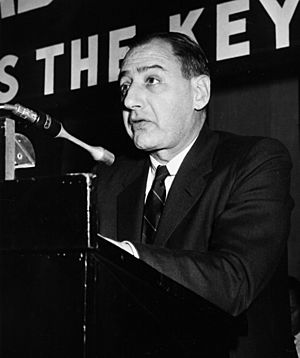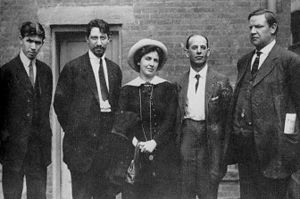Harold I. Cammer facts for kids
Quick facts for kids
Harold I. Cammer
|
|
|---|---|

Cammer speaking at a rally in Atlantic City, N.J.
|
|
| Born | June 18, 1909 |
| Died | October 21, 1995 (aged 86) Mamaroneck, New York, U.S.
|
| Nationality | American |
| Education | JD Harvard Law School |
| Alma mater | City College |
| Occupation | Lawyer |
| Employer | Boudin & Wittenberg (1932–1933), Zalkin & Cohen (1933–1936), Liebman, Robbins, Pressman & Leider (1936–1941), Witt & Cammer (1941-1948), fPressman, Witt & Cammer (1948–1949), Witt & Cammer, Cammer & Shapiro |
| Known for | defender of Ware Group members Nathan Witt, Lee Pressman, John Abt |
|
Notable work
|
Co-founder National Lawyers Guild |
| Spouse(s) | Florence Glantz |
| Children | Robert Cammer, Margaret Cammer |
Harold I. Cammer (born June 18, 1909 – died October 21, 1995) was an American lawyer. He helped start the National Lawyers Guild. He was known for working on cases about workers' rights, civil rights, peace, and freedom of speech. He often defended people who were accused of having communist ideas.
Contents
Harold Cammer's Early Life and Education
Harold Cammer was born in June 1909 in Manhattan, New York City. His parents, Harry and Anne Cammer, were immigrants from the Russian Empire.
He went to public schools in New York City. In 1929, he earned a degree from City College. He then went to Harvard Law School on a special scholarship. He earned his law degree in 1932.
Harold Cammer's Legal Career
Starting Out in Law
Harold Cammer started his law career in 1932. He worked for a few different law firms. In 1936, he joined his friend Lee Pressman at a firm.
In 1941, Cammer started his own law firm called Witt & Cammer with his friend Nathan Witt. Witt had left his job at the National Labor Relations Board after being accused of being part of the Communist Party.
Cammer's firm helped many important groups. These included the Congress of Industrial Organizations (CIO), which was a big union group. They also worked for unions like the Fur, Leather & Machine Workers Union, the Brewery Workers' Union, and the New York Teachers Union.
Serving During World War II
Harold Cammer paused his work as a lawyer to serve in the United States military during World War II.
Important Cases After the War
After the war, Cammer went back to his law firm. In 1948, his friend Lee Pressman joined the firm, and it was briefly called Pressman, Witt & Cammer.
Cammer became well-known for defending people who were called to testify before the House Un-American Activities Committee (HUAC). This committee investigated people suspected of being communists. On August 20, 1948, Cammer defended Ware Group members like Nathan Witt, Lee Pressman, and John Abt before HUAC.
Later, in 1950, Lee Pressman testified again and named Witt as a member of the Communist Party. Cammer continued to represent Witt and John Abt during these hearings.

In 1951, Cammer was one of many lawyers who defended 17 members of the Communist Party. These people were accused of planning to teach others to overthrow the government. Cammer worked with other famous lawyers on this case, including Carol Weiss King and Leonard Boudin.
Focus on Labor Law
Cammer's law practice mainly focused on labor law. He represented many different unions and their members. Some of his clients included the United Brewery Workers union, the Teachers Guild, and the Amalgamated Meat Cutters.
He often defended union members who were accused of being communists. In 1945, he also helped a group of sailors challenge a corrupt union president.
In 1968, Cammer was involved in a case about teachers in New York City. This case was part of the events that led to the Ocean Hill-Brownsville strike.
Cammer was the main lawyer for Ben Gold, the president of the Fur and Leather Workers' Union. Gold was accused of lying about his anti-communist oath, which was required by the Taft–Hartley Act. Cammer was found in contempt of court for sending a questionnaire to potential jurors. However, the Supreme Court of the United States later overturned his conviction in a case called Cammer v. United States in 1956.
In 1955, Nathan Witt left the firm. Ralph Shapiro joined, and the firm's name changed to Cammer & Shapiro. Harold Cammer stopped actively practicing law in the mid-1980s.
Important Associations
In 1937, Harold Cammer helped create the National Lawyers Guild. This was the first racially integrated bar association in the country. It was dedicated to working for fairness in society, including economic, racial, and social justice, through the legal system.
The Federal Bureau of Investigation and the United States Department of Justice later called the National Lawyers Guild a "communist front" group.
Working for Free (Pro Bono)
Cammer cared about more than just labor law. He worked as a pro bono attorney, meaning he offered his legal services for free, during the civil rights movement in the 1950s and 1960s.
He also defended nearly 700 students who were arrested during the Columbia University protests of 1968. Cammer and his son, Robert Cammer, who was also a lawyer, were part of the Lawyers Committee on American Policy Towards Vietnam. In 1965, they wrote a paper that said the United States' involvement in the Vietnam War was against the law.
Personal Life and Passing
Harold Cammer married Florence Glantz on January 25, 1936. They had two children, Robert and Margaret. Margaret became a judge in New York State.
Harold I. Cammer passed away at age 86 on October 21, 1995, at his home in Mamaroneck, New York. He was survived by his wife, son, daughter, grandson, and two great-granddaughters.
Legacy
Harold Cammer's important papers are kept at the Tamiment Library and Robert F. Wagner Archives at New York University.
See also
- Lee Pressman
- Nathan Witt
- John Abt
- Alger Hiss
- Whittaker Chambers
- National Lawyers Guild
- House Un-American Activities Committee


